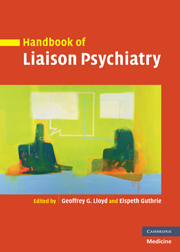Book contents
- Frontmatter
- Contents
- List of contributors
- Preface
- Part I Basic skills
- 1 The development of general hospital psychiatry
- 2 Establishing a service
- 3 Legal and ethical issues in liaison psychiatry
- 4 Understanding psychological reactions to physical illness
- 5 Detection of psychiatric disorders in the general hospital
- 6 The role of the nurse in liaison psychiatry
- Part II Common psychiatric problems across the general hospital
- Part III Working with specific units
- Part IV Treatment
- Part V Different treatment settings
- Index
- References
6 - The role of the nurse in liaison psychiatry
from Part I - Basic skills
Published online by Cambridge University Press: 10 December 2009
- Frontmatter
- Contents
- List of contributors
- Preface
- Part I Basic skills
- 1 The development of general hospital psychiatry
- 2 Establishing a service
- 3 Legal and ethical issues in liaison psychiatry
- 4 Understanding psychological reactions to physical illness
- 5 Detection of psychiatric disorders in the general hospital
- 6 The role of the nurse in liaison psychiatry
- Part II Common psychiatric problems across the general hospital
- Part III Working with specific units
- Part IV Treatment
- Part V Different treatment settings
- Index
- References
Summary
Introduction
This chapter:
outlines the development of mental health liaison nursing
identifies the core skills and competencies required for effective practice within the liaison setting
outlines the role of the mental health liaison nurse
outlines the role of the mental health liaison nurse in the care and treatment of individuals with specific mental health needs in the general hospital.
The role of the nurse within liaison psychiatry developed significantly throughout the 1990s, with many health service trusts employing mental health nurses to practise within the general hospital. The nursing role is closely linked to that of doctors and psychologists practising in this area, and is primarily concerned with the provision of specialist mental health nursing assessment and intervention in the general hospital. Nurses working within liaison psychiatry use the skills of consultation, liaison and collaborative working, providing a service that transcends traditional professional, departmental and organizational boundaries. Mental health liaison nurses (MHLNs) can be seen as working at the interface between psychiatry and general hospital services. This chapter provides an overview of:
the development of mental health liaison nursing
core skills and competencies for MHLNs
the role of the MHLN in relation to self-harm and the care of people with physical illness.
The development of mental health liaison nursing
The term ‘liaison nursing’ within the general hospital context is not new, having been used in the United States throughout the 1960s and 1970s (Jones 1989; Roberts 1997).
- Type
- Chapter
- Information
- Handbook of Liaison Psychiatry , pp. 102 - 122Publisher: Cambridge University PressPrint publication year: 2007



